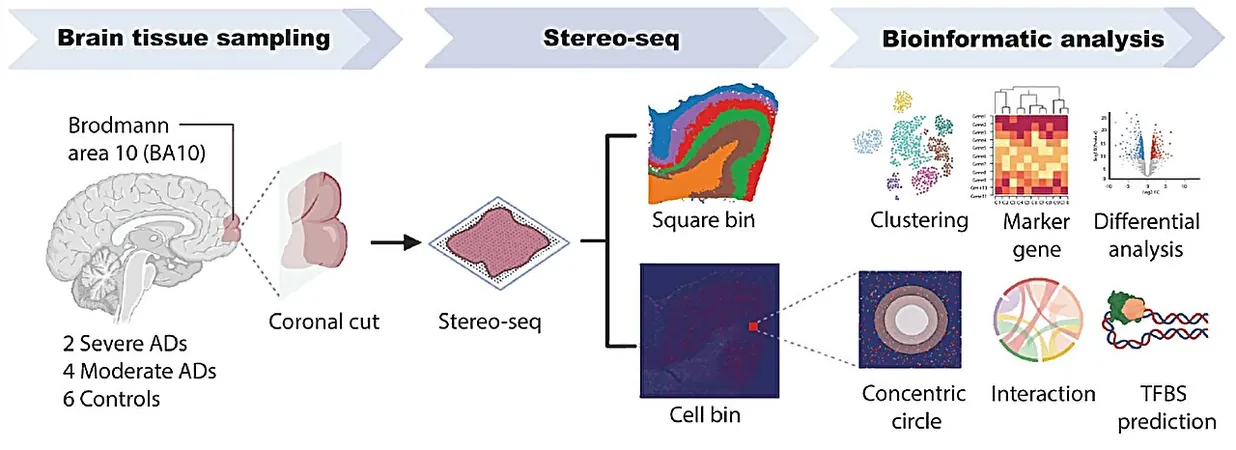
Breakthrough Brain Mapping Technique Unlocks Secrets of Alzheimer’s Disease
2025-05-05
Author: Jia
Revolutionary Mapping Reveals Alzheimer’s Mechanisms
In a groundbreaking study from Tulane University, scientists have unveiled an innovative subcellular map of the brain’s prefrontal cortex, a region significantly impacted by Alzheimer's disease. This pioneering technique is set to unravel the mysteries surrounding this degenerative brain condition.
Shedding Light on Dementia's Hidden World
The extensive research published in Nature Communications delineates the genetic factors contributing to the catastrophic loss of brain cells in Alzheimer’s patients. Notably, a specific protein, ZNF460, has emerged as a promising target for potential treatments.
Alzheimer's disease, which affects over 55 million individuals globally—comprising 60% to 70% of all dementia cases—remains largely shrouded in mystery. Current medications merely alleviate symptoms temporarily without halting the disease's progression, underscoring an urgent need for deeper understanding and new therapies.
Mapping the Brain Like Never Before
"The human brain is the most intricate organ, and deciphering diseases like Alzheimer’s presents a significant challenge," says Hui Shen, the study's senior author and associate director at the Center for Biomedical Informatics & Genomics. Utilizing cutting-edge spatial transcriptomics, researchers achieved a detailed map of the prefrontal cortex—essential for decision-making and emotional regulation—with single-cell resolution.
This next-generation technology enabled scientists to observe brain tissue with extraordinary clarity, revealing crucial genetic interactions within individual cells. The study meticulously examined samples from six brains at varying stages of Alzheimer's, paving the way for new insights.
The Downfall of Neuroprotective Mechanisms
Findings indicate that the genetic modules designed to protect neurons disintegrate or vanish in Alzheimer’s patients, facilitating the accumulation of harmful proteins that wreak havoc on brain cells. Lead author Yun Gong noted, "We've highlighted key molecular interactions that shield neurons under stress, which seem to vanish in those afflicted with Alzheimer’s. If we can activate ZNF460 to preserve these protective modules, we could potentially slow the disease's progression."
Uncharted Territory: Brain Structure Changes
In a surprising revelation, the study also reported that the layered architecture of the brain disintegrates as Alzheimer’s advances—a phenomenon previously unobserved. This finding could reshape our understanding of how Alzheimer’s impacts brain structure over time.
A Path Forward for Alzheimer's Research
Shen and Gong are eager to continue their research on ZNF460 to determine if its absence is a definitive indicator of Alzheimer's onset. "This represents just the beginning of our journey in exploring Alzheimer’s disease pathology," Shen explains. "Different brain areas may respond uniquely as the disease develops, so our next step is to investigate other regions comprehensively."


 Brasil (PT)
Brasil (PT)
 Canada (EN)
Canada (EN)
 Chile (ES)
Chile (ES)
 Česko (CS)
Česko (CS)
 대한민국 (KO)
대한민국 (KO)
 España (ES)
España (ES)
 France (FR)
France (FR)
 Hong Kong (EN)
Hong Kong (EN)
 Italia (IT)
Italia (IT)
 日本 (JA)
日本 (JA)
 Magyarország (HU)
Magyarország (HU)
 Norge (NO)
Norge (NO)
 Polska (PL)
Polska (PL)
 Schweiz (DE)
Schweiz (DE)
 Singapore (EN)
Singapore (EN)
 Sverige (SV)
Sverige (SV)
 Suomi (FI)
Suomi (FI)
 Türkiye (TR)
Türkiye (TR)
 الإمارات العربية المتحدة (AR)
الإمارات العربية المتحدة (AR)